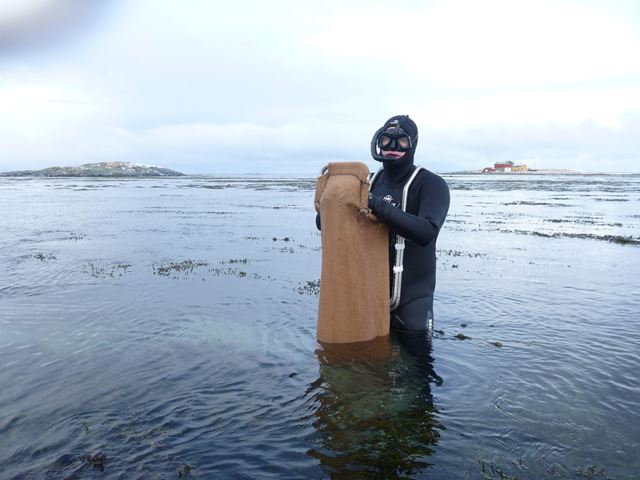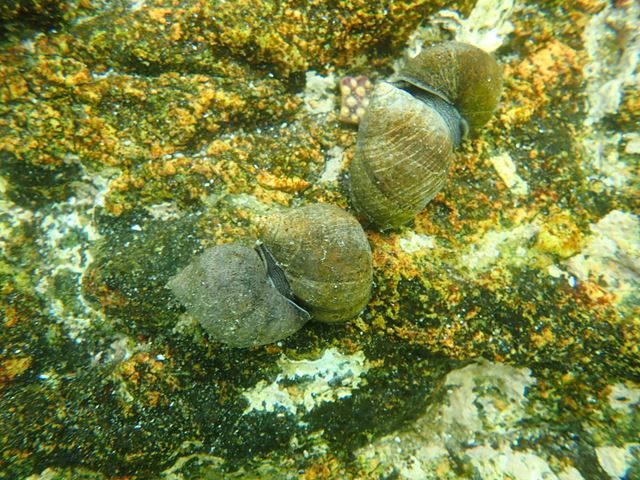“There are currently no periwinkle farms anywhere on the planet”, says Andreas Hagemann at SINTEF Ocean, who is leading SINTEF’s research efforts in this field. “People go out and gather the molluscs along the shoreline. But many of the conditions needed for commercial farming are now in place”, he says.
“We’ve succeeded, under laboratory conditions and for the first time in Norway, in hatching periwinkle eggs, raising the larvae, getting them to attach themselves to substrates, and finally developing into adult periwinkles. We’ll soon be expanding this project to see if we can get similar results on a bigger scale”, he adds.
SINTEF’s research results were presented at the Aqua Nor aquaculture expo in Trondheim in August this year.
No stranger on the shore
Periwinkles are not what you get when you order escargots in a French restaurant. Escargots are edible land snails. The common periwinkle, on the other hand, is a marine mollusc that lives in the intertidal zone. In France they go by the name of bigorneaux. Anyone can find them along the shoreline. They’re the tiny snails crawling around the rocks and among the seaweeds.

Jon Eirik Brennvall is a diver and General Manager of the company Statsnail AS. Here pictured with a bag full of periwinkles collected along the shore somewhere in Trøndelag county. Photo: Joakim Skjefstad
It is still a rare event to find periwinkles on Norwegian menus, but they are a very popular delicacy in France, Spain and Portugal, especially at Christmas. The British also like to nibble on these tiny molluscs with their pints in the pub. Periwinkles have been transformed from an everyday food to something of an exclusive delicacy. The price per kilo for living periwinkles is currently about the same as that for salmon.
Facts about the edible periwinkle
In the European market, periwinkles are transported in wholesale packaging and sent to fish markets or straight to the restaurants. They are commonly served as an appetiser with oysters or as part of a shellfish dish. Bigorneaux au naturel is prepared by boiling periwinkles for 90 seconds in salted water. You can also add spices or herbs to enhance the flavour. Periwinkles can also be heated in an oven, with garlic butter spread across the shell apertures, at 200°C for four minutes. It is important not to heat them for too long, or the flesh becomes too tough. (Source: Jon Eirik Brennvall)
Forty-four tonnes
A company called Statsnail AS has been established with its base at Opphaug in Ørland municipality in Trøndelag. In 2022, it exported 44 tonnes of wild periwinkles to the European market, but only 500 kilos to customers in Norway. There is no shortage of shoreline habitats in Norway, but weather conditions mean that the harvesting season is shorter than that in southern Europe. It is thus not ideal for Norwegian exporters that prices are low in summer but reach their peak as Christmas approaches. The periwinkles are exported live, after first being kept in tanks containing seawater.
Patience breeds success

Researcher Andreas Hagemann at SINTEF.
SINTEF’s involvement with periwinkles started in 2018. At that time, the researchers’ aim was to find out how the molluscs could be kept and fed in captivity after harvesting and in the period leading up to Christmas, so that they could be sold for the best possible price per kilo. The initial project involved using saltwater tanks installed on land. After collection from the shore, the periwinkles were kept in a recirculation facility. They were fed on green seaweeds, and the results were promising – they survived and developed well. They also tasted very similar to fresh animals collected from the shore.
Farming on land
“These excellent results led us to look into the potential for farming periwinkles in an onshore facility – from eggs right up to development of the adult snails”, says Hagemann.
“Together with exporters Statsnail and facility designers Nofitech, we obtained funding from the Regional Research Fund for Mid-Norway to finance a study looking into not only how we might create artificial environments that would encourage the periwinkles to reproduce, but also into how their eggs could be harvested, matured and hatched into larvae. We also planned to investigate what kinds of food the larvae and adult periwinkles preferred, as well as how fast they developed under different environmental conditions”, he says.
Problems on the substrate
The researchers started with adult periwinkles that were collected from the shore and transferred to a tank. Periwinkles are highly fertile, and a single female can produce as many as 100,000 eggs per year. After spawning, the eggs were moved into new tanks with different temperatures and salt concentrations in order to study how these factors influenced development times and survival rates. The eggs were hatched, releasing the larvae to swim freely in the water.
But a problem arose during the next stage. The researchers failed to identify the conditions needed to enable the larvae to settle on the substrate at the bottom of the tanks prior to their metamorphosis into bottom-living organisms.

Periwinkles are highly fertile. A female can produce as many as 100,000 eggs a year. Photo: Jon Eirik Brennvall
First in the world?
A new study was launched with more funding from the Regional Research Fund in Trøndelag. The breakthrough finally came after multiple experiments into feed and environmental conditions conducted at the Norwegian Centre for Plankton Technology. Ninety per cent of larvae survived to the point at which they were ready to settle on substrates at the bottom of their tanks.
“As far as we know, this is the first time this has been demonstrated under laboratory conditions”, says Hagemann.
After settling on the bottom, the larvae metamorphose into adult periwinkles with hard shells. The process from hatching to the development of adults that attach themselves to the substrate takes about a month.
Facts about periwinkles
The common periwinkle is a bottom-living (adult) and planktonic (larva) invertebrate that feeds mostly on plant material (low-trophic). Because of its biology and position in the food chain, it requires less energy than animals at higher trophic levels. Many species that live on waste materials, including periwinkles, can be incorporated into a so-called ‘circular bioeconomy’. For this reason, they can constitute key components in future nutrition strategies, either as feed ingredients or as food sources in their own right.
Biofilms may be the answer
Periwinkles have a powerful foot that protrudes from the shell and is used for mobility. The foot is equipped with a rough, rasping, tongue-like structure that the periwinkle uses to obtain plankton from the biofilm that covers the rocks on which it lives. SINTEF believes that this biofilm is the key to whether or not a larva will settle on a given substrate prior to developing into an adult. The researchers are planning to analyse microorganisms both in the sea and in substrate biofilms at locations where the company Statsnail has identified high densities of recently attached periwinkles. This information can be used to further improve development and survival rates in the lab.
Demo facility just around the corner
Statsnail is now in the process of constructing a demonstration periwinkle farm at Oksvoll in Trøndelag. The issue of feed represents a challenge in all types of farming – it can be very expensive and, in some situations, poorly sustainable.
“We’re planning to look into what kinds of microalgae are present naturally in the sea during spring when the periwinkles are spawning”, explains Hagemann. “When we’ve collected samples and analysed the data on which species are most numerous in the most viable algal communities, we’ll be able to optimise the feed provided at the farm facility by simulating what happens in nature. At the start of their lives, periwinkles feed on microscopic phytoplankton before later moving on to bottom-living algae. These are renewable resources produced by sunlight and photosynthesis”, he says.
Conserving wild periwinkle populations
Hagemann is hopeful that the successful lab results can be reproduced on a larger scale.
“It all seems very promising for periwinkle farming in Norway”, he says. “As well as producing an invaluable food resource, farming will reduce the pressure on wild populations. One of the benefits of aquaculture is that it is possible to produce and supply food all year round”, he says.

This giant female periwinkle is 51 millimetres long and weighs 34.2 grammes. It was collected at Valset in Agdenes in Trøndelag. Photo: Jon Eirik Brennvall
An optimistic pioneer
Jon Eirik Brennvall, who is owner and General Manager at Statsnail, believes that the prospects for periwinkle farming are exciting.
“SINTEF has solved the problem of larvae production”, he says. “This autumn we’ll be starting operations at the demo facility at Valsholma (Oksvoll). We expect to produce anything up to ten tonnes of periwinkles a year. In ten years’ time, if everything goes as we hope, we may be able to deliver several hundred tonnes, perhaps as much as 1,000 tonnes, a year. It took time to develop salmon farming into the massive industry it is today. I believe that in 20 to 40 years’ time, periwinkle farming can also become a viable business, provided that the authorities play ball”, he says.
The fact that total annual production in Europe is only between 1,000 and 2,000 tonnes doesn’t worry our periwinkle pioneer. He believes that the market is far from saturated. In the record year of 1997, as much as 8,000 tonnes were produced, and Brennvall believes that the market could expand significantly once commercial farming becomes established.
P.S. In spite of its name, the company Statsnail has nothing to do with the Norwegian state. It is currently owned and managed by Jon Eirik Brennvall.
SINTEF’s most recent research in this field is published in the article: Lillebjerka, T., Malzahn, A. M., Kjørsvik, E. and Hagemann, A. (2023). Effects of temperature, salinity and diet on embryonic and early larval development in Littorina littorea (Gastropoda: Littorinimorpha). Frontiers in Marine Science, 10, 1240599.


